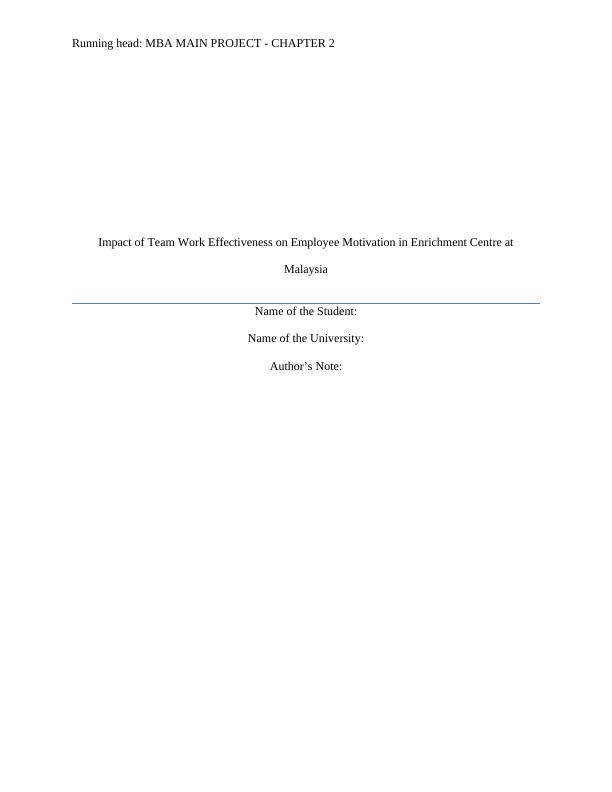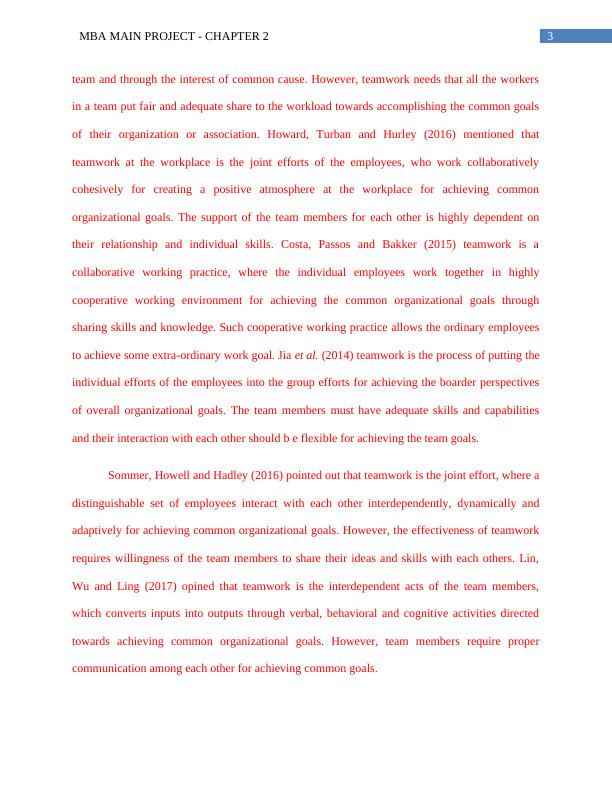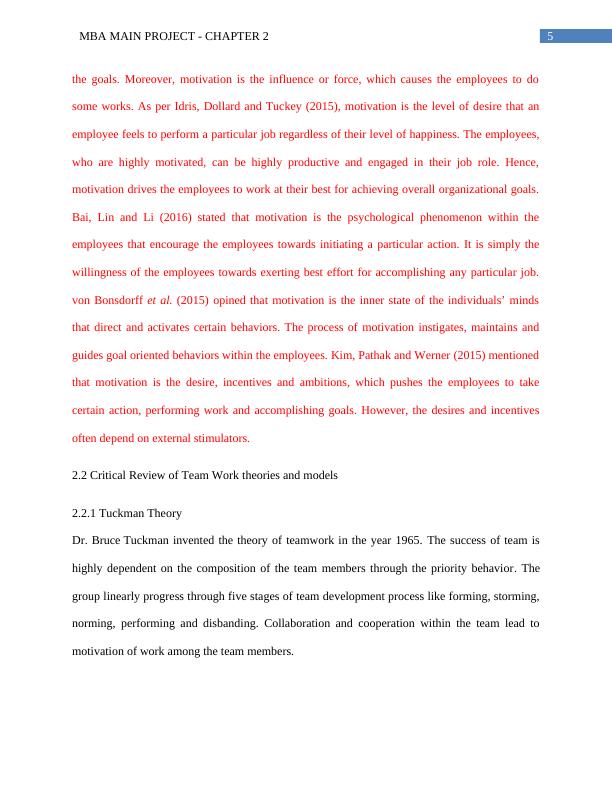Impact of Team Work Effectiveness on Employee Motivation in Enrichment Centre at Malaysia
Impact of Team Work Effectiveness on Employee Motivation in Enrichment Centre at Malaysia
28 Pages8976 Words455 Views
Added on 2023-06-10
About This Document
This literature review explores the impact of team work effectiveness on employee motivation in an enrichment centre in Malaysia. The review defines key concepts of teamwork and motivation, critically reviews theories and models such as Tuckman Theory and Belbin's Model, and examines empirical studies in Malaysia and globally.
Impact of Team Work Effectiveness on Employee Motivation in Enrichment Centre at Malaysia
Impact of Team Work Effectiveness on Employee Motivation in Enrichment Centre at Malaysia
Added on 2023-06-10
ShareRelated Documents
Running head: MBA MAIN PROJECT - CHAPTER 2
Impact of Team Work Effectiveness on Employee Motivation in Enrichment Centre at
Malaysia
Name of the Student:
Name of the University:
Author’s Note:
Impact of Team Work Effectiveness on Employee Motivation in Enrichment Centre at
Malaysia
Name of the Student:
Name of the University:
Author’s Note:

1MBA MAIN PROJECT - CHAPTER 2
Table of Contents
2.0 Literature Review......................................................................................................................2
2.1 Definition of Key Concepts...................................................................................................2
2.1.1 Teamwork.......................................................................................................................2
2.1.2 Motivation.......................................................................................................................4
2.2 Critical Review of Team Work theories and models.............................................................5
2.2.1 Tuckman Theory.............................................................................................................5
2.2.2 Belbin’s Model...............................................................................................................7
2.2.3 T7 Model........................................................................................................................9
2.2.4 GRPI Model..................................................................................................................10
2.2.5 Heckman Model............................................................................................................12
2.2.6 The Lafasto and Larson Model.....................................................................................13
2.3 Empirical studies.................................................................................................................15
2.3.1 Empirical studies in Malaysia.......................................................................................15
2.3.2 Empirical studies Global...............................................................................................18
Reference List................................................................................................................................22
Table of Contents
2.0 Literature Review......................................................................................................................2
2.1 Definition of Key Concepts...................................................................................................2
2.1.1 Teamwork.......................................................................................................................2
2.1.2 Motivation.......................................................................................................................4
2.2 Critical Review of Team Work theories and models.............................................................5
2.2.1 Tuckman Theory.............................................................................................................5
2.2.2 Belbin’s Model...............................................................................................................7
2.2.3 T7 Model........................................................................................................................9
2.2.4 GRPI Model..................................................................................................................10
2.2.5 Heckman Model............................................................................................................12
2.2.6 The Lafasto and Larson Model.....................................................................................13
2.3 Empirical studies.................................................................................................................15
2.3.1 Empirical studies in Malaysia.......................................................................................15
2.3.2 Empirical studies Global...............................................................................................18
Reference List................................................................................................................................22

2MBA MAIN PROJECT - CHAPTER 2
2.0 Literature Review
2.1 Definition of Key Concepts
2.1.1 Teamwork
Hu and Liden (2015) opined that teamwork is the collaborative effort of a team towards
achieving a common goal or completing a particular task in efficient and effective manner. The
members of a team work interdependently towards achieving the common goals of the team.
Moreover, teamwork presents the context, where group of people work together in collaboration
with each other for achieving the common organizational goals. Teamwork is the practice of
working collaboratively with a group of employees for achieving common organizational goals.
Moreover, in teamwork, the team members work in collaboration with each other and have their
interdependence on each other. However, Choi, Kim and Kang (2017) argued that despite of
interdependence, the team members must have their individual skills for better achieving the
organizational goals in unique way. Weer, DiRenzo and Shipper (2016) stated that teamwork is
the joint activities by the group of people in which the individual interest of the employees is
subordinated into group efficiency and unity and harmonized effort. Moreover, the individual
skills and strengths of the individual team members are joined together with shared goal for
achieving the overall team goal.
Dong et al. (2015) opined teamwork is the cooperation among the group of employees,
which is intended towards sharing the ideas and skills for achieving the common organizational
goals. However, the willingness of the employees to cooperate with each other stems from the
relationship of the team members with each other. Barrick et al. (2015) teamwork is the
coordinated and cooperative effort on the part of a group of employees, who work together as a
2.0 Literature Review
2.1 Definition of Key Concepts
2.1.1 Teamwork
Hu and Liden (2015) opined that teamwork is the collaborative effort of a team towards
achieving a common goal or completing a particular task in efficient and effective manner. The
members of a team work interdependently towards achieving the common goals of the team.
Moreover, teamwork presents the context, where group of people work together in collaboration
with each other for achieving the common organizational goals. Teamwork is the practice of
working collaboratively with a group of employees for achieving common organizational goals.
Moreover, in teamwork, the team members work in collaboration with each other and have their
interdependence on each other. However, Choi, Kim and Kang (2017) argued that despite of
interdependence, the team members must have their individual skills for better achieving the
organizational goals in unique way. Weer, DiRenzo and Shipper (2016) stated that teamwork is
the joint activities by the group of people in which the individual interest of the employees is
subordinated into group efficiency and unity and harmonized effort. Moreover, the individual
skills and strengths of the individual team members are joined together with shared goal for
achieving the overall team goal.
Dong et al. (2015) opined teamwork is the cooperation among the group of employees,
which is intended towards sharing the ideas and skills for achieving the common organizational
goals. However, the willingness of the employees to cooperate with each other stems from the
relationship of the team members with each other. Barrick et al. (2015) teamwork is the
coordinated and cooperative effort on the part of a group of employees, who work together as a

3MBA MAIN PROJECT - CHAPTER 2
team and through the interest of common cause. However, teamwork needs that all the workers
in a team put fair and adequate share to the workload towards accomplishing the common goals
of their organization or association. Howard, Turban and Hurley (2016) mentioned that
teamwork at the workplace is the joint efforts of the employees, who work collaboratively
cohesively for creating a positive atmosphere at the workplace for achieving common
organizational goals. The support of the team members for each other is highly dependent on
their relationship and individual skills. Costa, Passos and Bakker (2015) teamwork is a
collaborative working practice, where the individual employees work together in highly
cooperative working environment for achieving the common organizational goals through
sharing skills and knowledge. Such cooperative working practice allows the ordinary employees
to achieve some extra-ordinary work goal. Jia et al. (2014) teamwork is the process of putting the
individual efforts of the employees into the group efforts for achieving the boarder perspectives
of overall organizational goals. The team members must have adequate skills and capabilities
and their interaction with each other should b e flexible for achieving the team goals.
Sommer, Howell and Hadley (2016) pointed out that teamwork is the joint effort, where a
distinguishable set of employees interact with each other interdependently, dynamically and
adaptively for achieving common organizational goals. However, the effectiveness of teamwork
requires willingness of the team members to share their ideas and skills with each others. Lin,
Wu and Ling (2017) opined that teamwork is the interdependent acts of the team members,
which converts inputs into outputs through verbal, behavioral and cognitive activities directed
towards achieving common organizational goals. However, team members require proper
communication among each other for achieving common goals.
team and through the interest of common cause. However, teamwork needs that all the workers
in a team put fair and adequate share to the workload towards accomplishing the common goals
of their organization or association. Howard, Turban and Hurley (2016) mentioned that
teamwork at the workplace is the joint efforts of the employees, who work collaboratively
cohesively for creating a positive atmosphere at the workplace for achieving common
organizational goals. The support of the team members for each other is highly dependent on
their relationship and individual skills. Costa, Passos and Bakker (2015) teamwork is a
collaborative working practice, where the individual employees work together in highly
cooperative working environment for achieving the common organizational goals through
sharing skills and knowledge. Such cooperative working practice allows the ordinary employees
to achieve some extra-ordinary work goal. Jia et al. (2014) teamwork is the process of putting the
individual efforts of the employees into the group efforts for achieving the boarder perspectives
of overall organizational goals. The team members must have adequate skills and capabilities
and their interaction with each other should b e flexible for achieving the team goals.
Sommer, Howell and Hadley (2016) pointed out that teamwork is the joint effort, where a
distinguishable set of employees interact with each other interdependently, dynamically and
adaptively for achieving common organizational goals. However, the effectiveness of teamwork
requires willingness of the team members to share their ideas and skills with each others. Lin,
Wu and Ling (2017) opined that teamwork is the interdependent acts of the team members,
which converts inputs into outputs through verbal, behavioral and cognitive activities directed
towards achieving common organizational goals. However, team members require proper
communication among each other for achieving common goals.

4MBA MAIN PROJECT - CHAPTER 2
2.1.2 Motivation
Li, Chiaburu and Kirkman (2017) stated that motivation defines the external and internal
factors, which stimulate the energy and desire of the employees to be continually committed and
interested in a job role for attaining the job goals. Moreover, it becomes the reason for acting and
behaving in a particular way. Kanfer and Chen (2016) pointed out that motivation acts as the
stimulator for the needs, desire and action of the people, which stimulates the employees to
behave in a particular manner and encourage the employees to repeat the behavior. It is generally
resulted from both unconscious and conscious factors like intensity of needs, incentives of goals
and expectation of individuals and their peers. Anitha and Begum (2016) stated that motivation
is the process that initiates with psychological and physiological deficiency or need, which
activates or drives the behavior towards a goal. It is always internal to the employees and it is
externalized through their behavior. Wang, Waldman and Zhang (2014) pointed out that
motivation is the willingness of the employees towards exerting high levels of efforts for meeting
organizational goals as well as satisfying some individual needs. It stimulates the willingness
among the employees towards performing some behaviors in a specific manner. Moreover,
motivation enhances the enthusiasm within the employees towards achieving any particular goal.
According to Boxall, Hutchison and Wassenaar (2015), motivation is the outcome of the
processes, external and internal to the individual, which arouses persistence and enthusiasm
among the employees for pursuing some source of actions. The process of motivation stimulates
the employees towards initiating a particular action. Furthermore, the factors of motivation
become the reasons for behaving in a certain way. Grille, Schulte and Kauffeld (2015) mentioned
that motivation creates willingness among the employees towards performing at the best of their
abilities. However, the stimulus must be aroused for motivating the employees towards achieving
2.1.2 Motivation
Li, Chiaburu and Kirkman (2017) stated that motivation defines the external and internal
factors, which stimulate the energy and desire of the employees to be continually committed and
interested in a job role for attaining the job goals. Moreover, it becomes the reason for acting and
behaving in a particular way. Kanfer and Chen (2016) pointed out that motivation acts as the
stimulator for the needs, desire and action of the people, which stimulates the employees to
behave in a particular manner and encourage the employees to repeat the behavior. It is generally
resulted from both unconscious and conscious factors like intensity of needs, incentives of goals
and expectation of individuals and their peers. Anitha and Begum (2016) stated that motivation
is the process that initiates with psychological and physiological deficiency or need, which
activates or drives the behavior towards a goal. It is always internal to the employees and it is
externalized through their behavior. Wang, Waldman and Zhang (2014) pointed out that
motivation is the willingness of the employees towards exerting high levels of efforts for meeting
organizational goals as well as satisfying some individual needs. It stimulates the willingness
among the employees towards performing some behaviors in a specific manner. Moreover,
motivation enhances the enthusiasm within the employees towards achieving any particular goal.
According to Boxall, Hutchison and Wassenaar (2015), motivation is the outcome of the
processes, external and internal to the individual, which arouses persistence and enthusiasm
among the employees for pursuing some source of actions. The process of motivation stimulates
the employees towards initiating a particular action. Furthermore, the factors of motivation
become the reasons for behaving in a certain way. Grille, Schulte and Kauffeld (2015) mentioned
that motivation creates willingness among the employees towards performing at the best of their
abilities. However, the stimulus must be aroused for motivating the employees towards achieving

5MBA MAIN PROJECT - CHAPTER 2
the goals. Moreover, motivation is the influence or force, which causes the employees to do
some works. As per Idris, Dollard and Tuckey (2015), motivation is the level of desire that an
employee feels to perform a particular job regardless of their level of happiness. The employees,
who are highly motivated, can be highly productive and engaged in their job role. Hence,
motivation drives the employees to work at their best for achieving overall organizational goals.
Bai, Lin and Li (2016) stated that motivation is the psychological phenomenon within the
employees that encourage the employees towards initiating a particular action. It is simply the
willingness of the employees towards exerting best effort for accomplishing any particular job.
von Bonsdorff et al. (2015) opined that motivation is the inner state of the individuals’ minds
that direct and activates certain behaviors. The process of motivation instigates, maintains and
guides goal oriented behaviors within the employees. Kim, Pathak and Werner (2015) mentioned
that motivation is the desire, incentives and ambitions, which pushes the employees to take
certain action, performing work and accomplishing goals. However, the desires and incentives
often depend on external stimulators.
2.2 Critical Review of Team Work theories and models
2.2.1 Tuckman Theory
Dr. Bruce Tuckman invented the theory of teamwork in the year 1965. The success of team is
highly dependent on the composition of the team members through the priority behavior. The
group linearly progress through five stages of team development process like forming, storming,
norming, performing and disbanding. Collaboration and cooperation within the team lead to
motivation of work among the team members.
the goals. Moreover, motivation is the influence or force, which causes the employees to do
some works. As per Idris, Dollard and Tuckey (2015), motivation is the level of desire that an
employee feels to perform a particular job regardless of their level of happiness. The employees,
who are highly motivated, can be highly productive and engaged in their job role. Hence,
motivation drives the employees to work at their best for achieving overall organizational goals.
Bai, Lin and Li (2016) stated that motivation is the psychological phenomenon within the
employees that encourage the employees towards initiating a particular action. It is simply the
willingness of the employees towards exerting best effort for accomplishing any particular job.
von Bonsdorff et al. (2015) opined that motivation is the inner state of the individuals’ minds
that direct and activates certain behaviors. The process of motivation instigates, maintains and
guides goal oriented behaviors within the employees. Kim, Pathak and Werner (2015) mentioned
that motivation is the desire, incentives and ambitions, which pushes the employees to take
certain action, performing work and accomplishing goals. However, the desires and incentives
often depend on external stimulators.
2.2 Critical Review of Team Work theories and models
2.2.1 Tuckman Theory
Dr. Bruce Tuckman invented the theory of teamwork in the year 1965. The success of team is
highly dependent on the composition of the team members through the priority behavior. The
group linearly progress through five stages of team development process like forming, storming,
norming, performing and disbanding. Collaboration and cooperation within the team lead to
motivation of work among the team members.

End of preview
Want to access all the pages? Upload your documents or become a member.
Related Documents
MBA Main Project Assignmentlg...
|28
|8173
|98
Impact of Teamwork Effectiveness on Employee Motivation in Enrichment Centre at Malaysialg...
|26
|13650
|125
Impact of Teamwork Effectiveness on Employee Motivation in Enrichment Centre at Malaysialg...
|90
|34325
|306
Report on Team work, Communication and Ethicslg...
|11
|2755
|209
Benefits of Team Working for Companieslg...
|17
|1263
|64
The Importance of Teamwork in the workplacelg...
|10
|1741
|89
